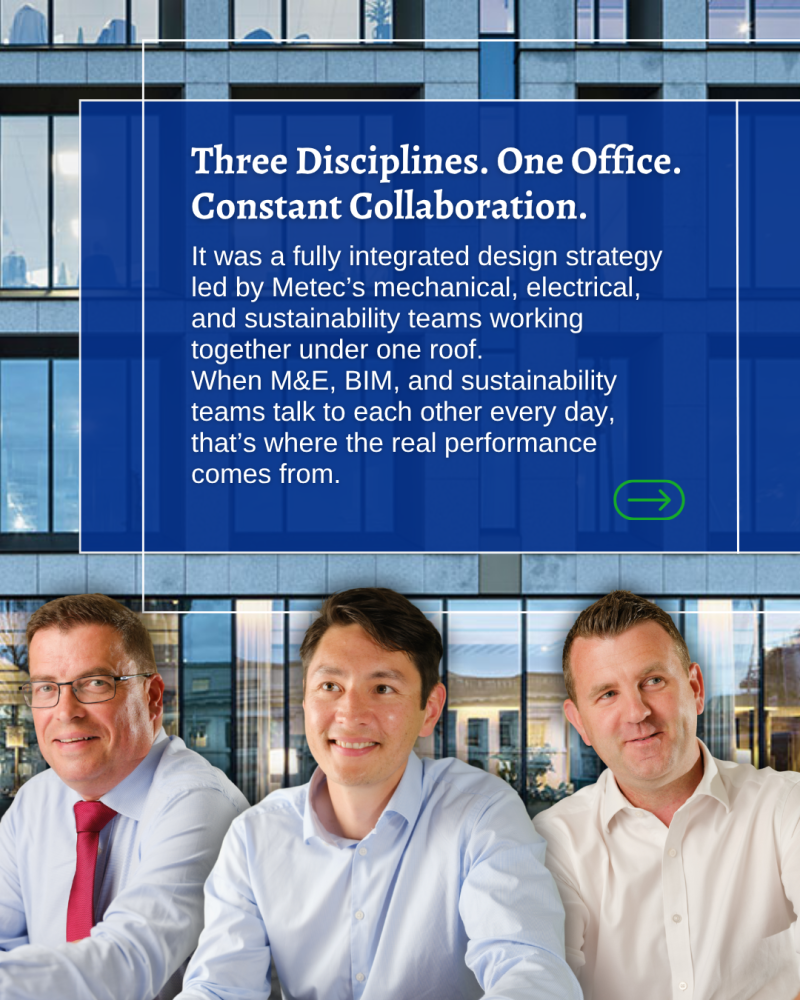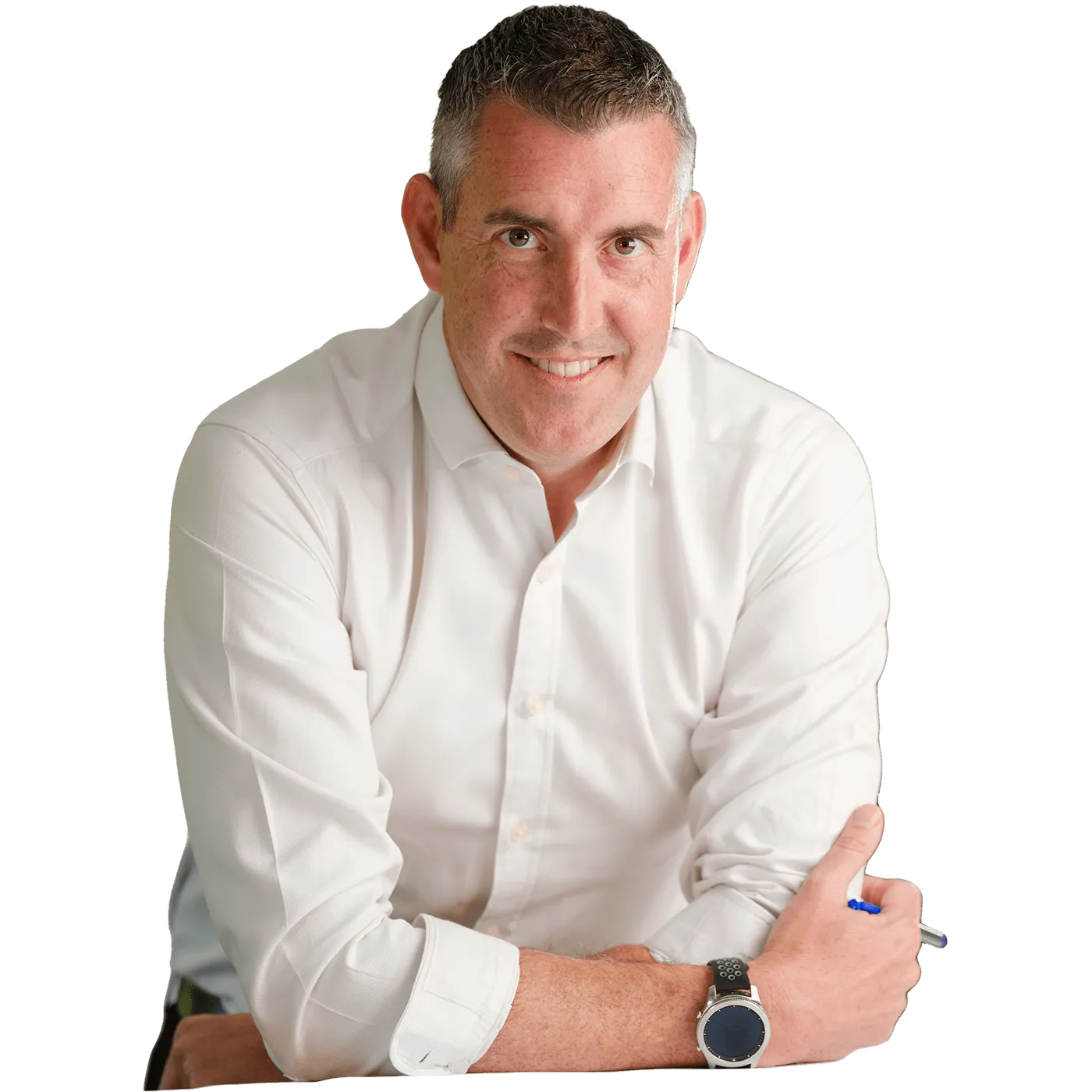Why Fifteen George’s Quay Achieved Ireland’s Highest LEED v4 Score
What cost consultants, architects, and developers can learn from the engineering approach behind Ireland’s highest LEED v4 score.
Fifteen George’s Quay achieved Ireland’s highest recorded LEED v4 score at the time of certification. But the real story isn’t the plaque - it’s the engineering decisions made years earlier that shaped the outcome. As Scott Caldwell, Associate Director, Head of Sustainability, put it:
“Being involved from concept stage meant we could identify the ideal route to achieving certification.”
1. Early involvement shaped the entire strategy
Metec joined in 2018 at concept design - long before façade decisions, system layouts, or cost reviews were final.
That early collaboration between M&E, Sustainability, and BIM meant:
- The energy model guided the design, not validated it afterwards
- Embodied carbon decisions were made before demolition or procurement
- Plant, façade, and roof coordination happened before constraints locked in
- The strongest credit opportunities were understood from the start
And importantly, this strategy was developed alongside the architect and structural engineers, who played a key role in shaping the reused structure and façade approach.
Scott summed it up simply:
“If you’re there from the beginning, you can make sure nothing is missed.”
2. Reusing the structure delivered the biggest carbon win
One of the most consequential decisions was also the earliest: retain and reuse the existing structure. This avoided major embodied carbon, strengthened the Materials & Resources category, and set the trajectory for a high-scoring project.
“Reusing the existing structure saved a massive amount of embodied carbon. That was core to the LEED strategy.” - Scott Caldwell
This decision was a collaborative one -combining architectural design, structural engineering logic, and sustainability analysis - and it was a major factor in Fifteen George’s Quay becoming Ireland’s highest-scoring LEED v4 project at the time.
3. Energy performance without burdening tenants
The Energy & Atmosphere category is one of the toughest under LEED v4. The project secured 22 out of 33 points, including:
- Solar PV
- Advanced metering
- Demand response infrastructure
- Low-GWP refrigerants
- Green power procurement
But the approach was just as important as the result.
“We wanted strong energy performance without tying tenants to restrictive requirements.” - Scott Caldwell
Rather than pushing efficiency obligations onto future occupiers, the base-build systems carried most of the performance - making the building attractive to ESG-focused tenants without creating onerous fit-out demands.
4. Daylight and indoor air quality were designed in early
Two categories scored exceptionally well:
1. Daylight
The narrow floorplate achieved maximum daylight points -something rarely possible in deeper-plan offices.
“Because it’s a narrow building, the daylight performance was exceptional.” - Scott Caldwell
2. Indoor Environmental Quality
Enhanced fresh air, filtration, CO₂ monitoring, and low-emitting materials were integrated through tight coordination between mechanical and sustainability teams.
And crucially - these credits were delivered with major contributions from the architect and main contractor, as Scott noted:
“A lot of the low-emitting materials and product selections came from collaboration between the architect and the contractor -they did a very good job on that.” - Scott Caldwell
This ensured the IEQ strategy wasn’t just designed well, but built well.
5. BIM protected the performance strategy
BIM was a central coordination tool - not a box-ticking exercise.
“BIM identified issues before they ever reached site. It saved time and protected the performance strategy.” - Scott Caldwell
This was especially important in a reused structure, where services, plant, façade interfaces, acoustic measures, and daylight strategy all had to be carefully coordinated.
6. Innovation credits reflected real design decisions
The project achieved 5 out of 5 innovation credits for:
- Rainwater reuse
- Acoustic performance of rooftop plant
- Social equity in sourcing
- Transit accessibility
- Reduced parking footprint
“These credits came from actual design decisions -not from trying to be clever with the paperwork.” - Scott Caldwell
Once again, this was achieved through coordinated input across the full design and construction team.
7. LEED v5 raises the bar
LEED v5 will become available soon, with tighter thresholds and greater emphasis on carbon and community impact.
Scott’s advice is clear:
“LEED v5 will be harder. People need to be aware the thresholds are changing.” - Scott Caldwell
For project teams, it means:
- Early modelling will matter even more
- Embodied carbon will become a larger differentiator
- Coordination will need to start earlier
- Decisions made at concept stage will carry even more weight

The takeaway
Ireland’s highest LEED v4 score wasn’t achieved through documentation. It was engineered through:
- Early involvement from 2018
- Integrated Mechanical, Electrical, Sustainability, and BIM teams
- A strong collaborative relationship with the architect, C&S engineer, and main contractor
- Intelligent reuse of structure
- Protecting tenants from burdensome ESG obligations
- Proactive coordination from concept to completion
And above all:
“The score isn’t decided at submission - it’s decided in the first months of design.” - Scott Caldwell

Fifteen George’s Quay shows what’s possible when performance is built in from day one - and when the full design and construction team pulls in the same direction.
More insights from the team HERE.
Talk to the team HERE.




.png)


